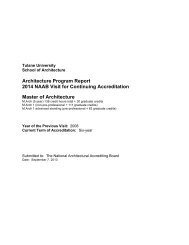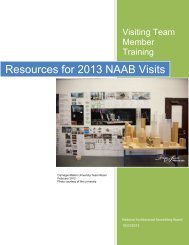Architecture Program Report Tulane University New Orleans ...
Architecture Program Report Tulane University New Orleans ...
Architecture Program Report Tulane University New Orleans ...
Create successful ePaper yourself
Turn your PDF publications into a flip-book with our unique Google optimized e-Paper software.
personnel, who believe their economic progress to be severely limited. *<br />
7. Location<br />
Noted as a 'strength' in this analysis, it should also be said that the City of <strong>New</strong> <strong>Orleans</strong><br />
is chronically plagued with economic and social problems. Though characterized as a<br />
splendid environment to attend school, these economic and social issues are also<br />
serious disincentives to students—and some faculty. While conditions have indeed<br />
improved under the city's new administration, the reversal of civic progress over the past<br />
several decades seriously threaten student enrollment and the attraction and retention of<br />
highly qualified faculty and staff.<br />
C. Opportunities<br />
There are several areas of opportunity that the School of <strong>Architecture</strong> can aggressively<br />
explore to increase enrollment and achieve national distinction.<br />
1. <strong>Tulane</strong> City Center (Downtown Center)<br />
One of the new initiatives under development is a <strong>Tulane</strong> City Center (Downtown<br />
Center). This Center will house several components of the School of <strong>Architecture</strong>,<br />
including Historic Preservation, the <strong>Tulane</strong> Regional Urban Design Center (TRUDC), the<br />
projected Leisure Institute and the <strong>New</strong> <strong>Orleans</strong> Urban Design Center. As a satellite of<br />
the program, the <strong>Tulane</strong> City Center would locate projects that serve local and regional<br />
communities. It would also establish a strong presence for <strong>Tulane</strong> in the city. This Center<br />
is specifically called for in the <strong>Tulane</strong> Renewal Plan and will provide an excellent<br />
foundation for the future of the School in the post-Katrina environment.<br />
.<br />
2. Service Learning Enhancements<br />
The expansion of Service Learning opportunities, a longstanding tradition within the<br />
study and practice of architecture.<br />
3. Promotion of a new approach to 'diversity' planning.<br />
With the <strong>Tulane</strong>/Xavier/Dillard project, the School of <strong>Architecture</strong> can begin to make<br />
headway into a difficult aspect of the discipline and practice of architecture: its lack of<br />
diversity, particularly racial and ethnic diversity.<br />
4. Foreign Study Opportunities<br />
As noted elsewhere, the practice of architecture is increasingly being practiced globally,<br />
and in culturally diverse circumstances. The value of foreign study as part of each<br />
student's curriculum is apparent to faculty and students alike. <strong>Tulane</strong> School of<br />
<strong>Architecture</strong> has strengthened its summer foreign study and research opportunities. In<br />
some cases, it has instituted partnerships with foreign universities to provide for<br />
semester-long study thereby developing programs that enable an ever greater number<br />
of students to participate. However, there is still room for further development. Other<br />
institutions have been far more aggressive about establishing foreign centers and<br />
semester-long programs available to all students. For <strong>Tulane</strong> in general, and the School<br />
in particular, more and varying types of foreign study must be made available. In<br />
addition, the <strong>University</strong> is attempting to strategically position itself as a gateway to the














